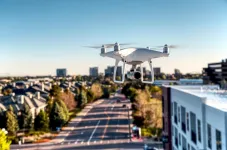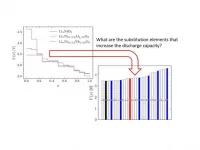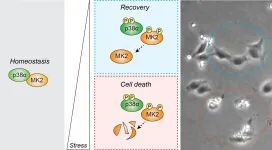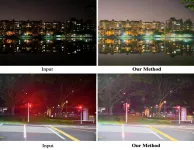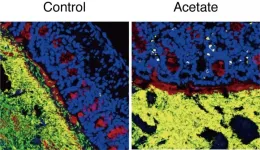(Press-News.org) "The project's main objective is to integrate a certain degree of automation, so that an operator can control a small fleet of up to 10 drones from a single ground station," says Luis E. Moreno, LABYRINTH's coordinator and researcher at the UC3M's Robotics Lab. "The idea is that the operator indicates the mission to be undertaken (for example, monitoring traffic in a particular area) and the system automatically converts this mission into a set of routes that each drone has to follow, automatically calculating alternative routes when necessary," he explains. In addition to planning and controlling routes, two other areas of technology are being subject to work: communication using 5G networks (so that drones are connected at all times) and the computer security behind the entire system.
Researchers have already developed an initial strategy for planning routes and preventing collisions for drone swarms in three-dimensional environments, in an article published in the Sensors journal. In order to do this, they first designed a 3D model that simulates an urban environment, where they established take-off and landing zones. Then they tested a planning algorithm that was responsible for calculating optimal, fluid routes for a set of drones. Finally, they implemented different measures (flights at different altitudes, distance control, etc.) to obtain a strategy for avoiding possible collisions.
Researchers at the LABYRINTH project are developing these technologies within the framework of U-Space, a new European drone air traffic management system led by the SESAR (Single European Sky ATM Research) initiative. This new framework is designed to integrate low-level drone operations, below 120 metres (400 feet), safely and efficiently into European airspace.
"Air controllers use ATM (Air Traffic Management) to safely manage the traffic of commercial aircraft. Similarly, developing an Unmanned Traffic Management (UTM) system that allows drones to share airspace with other drones and aircraft is imperative," explains Francisco Valera, another scientist taking part in this project and a member of NETCOM (Networks and Communications Services) at the UC3M. This research group, along with Telefonica I+D and the IMDEA Networks Institute, recently presented an experimental study about the use of mobile technologies in drone networks in the Sensors journal.
Possible applications
Drones can be useful in different applications, such as delivering and transporting goods, monitoring in different environments, or accessing places that are difficult to reach in emergency situations, for example. However, there have been concerns about the safety of these flights until now, which have limited their use and it is often illegal to use drones in certain public areas. It is estimated that by 2035 there will be approximately 400,000 drones flying within Europe, so the biggest challenge in this regard will be safely managing drone traffic in cities and other areas with high levels of congestion.
The foreseen applications within the LABYRINTH project framework concern different environments in Spain. For example, work is being undertaken with the Directorate-General for Traffic (DGT, in its Spanish acronym) to use drones to improve road transport, analysing aspects such as speed control, measuring the distance between vehicles, identifying license plates, and following up on and providing support in the event of accidents. Another initiative with the National Institute of Aerospace Technology (INTA, in its Spanish acronym) is intending to use drones at airports to control unauthorised access, inspect tracks, or use them as a deterrent against birds. In the case of managing emergencies at large gatherings (such as at concerts or sporting events), a collaboration with the SAMUR-Protección Civil of Madrid is in place for pre-emergency surveillance operations (identifying exit routes, medical care points or danger zones, calculating street capacity) and assistance with medical operations (faster routes to incidents, transporting specialised material or medicine).
LABYRINTH (Ensuring drone traffic control and safety) is a project funded by the European Union's H2020 Programme (GA 861696) that is being coordinated by the UC3M. This R&D&I consortium is made up of 13 research centres and industrial partners from 5 countries (Germany, Austria, Belgium, Spain, and Italy). The Spanish institutions that are participating, along with the UC3M, are the Directorate-General for Traffic (DGT), the National Institute of Aerospace Technology (INTA), the SAMUR-ProtecciónCivil of Madrid and the companies Expace on Board Systems, Inncome, PONS Seguridad Vial and Telefonica I+D. The Western Ligurian Sea Port Authority (Italy), the German Aerospace Center (DLR), the German Institute for Standardization (DIN), the Austrian Institute of Technology (AIT), and the European Organisation for the Safety of Air Navigation (EUROCONTROL) are also taking part in the project.
More information: Website for the LABYRINTH project: http://labyrinth2020.eu
Video: https://youtu.be/cvz1A_tkCZM
INFORMATION:
The economic and environmental pros and cons of melting Arctic ice creating shorter shipping routes through the polar region are weighed up in ground-breaking research from UCL experts in energy and transport.
They conclude that policy makers must properly assess the environmental trade-offs and costs in addition to the commercial benefits and opportunities in Arctic shipping. The authors also want to see more incentives to drive technological developments that will accelerate the uptake of green fuels and technologies.
The Arctic is the fastest-warming region on the planet.
Shorter Arctic shipping routes, which mean less fuel used are already used by a handful of ships, when areas of the Arctic ice melt ...
Ishikawa, Japan - Powering everything from smartphones to electric cars, lithium-ion batteries (LIBs) have evolved markedly with advances in technology and revolutionized our world. The next step in the progress of technology is developing even better batteries to power electronic devices for longer durations. One promising technique for increasing battery performance involves the atomic substitution of positively charged ions or "cations" in the cathode material. However, doing so systematically for different substituent cations to determine the ideal ones experimentally is complex and expensive, leaving us with simulations as the only viable option for narrowing down the choices.
Several studies have reported an improved battery life and ...
This summer, if you see a butterfly with wings that are blue on top with orange spots underneath, you may have crossed paths with a male European Common Blue (or Polyommatus icarus), a newly introduced species in Canada.
Could it be a fluke? Probably not, according to a group of researchers from the University of Ottawa who have taken a close look at this captivating blue creature. They are in fact the first to study its ecology.
"The results of our study suggest that the Polyommatus icarus (P. icarus) could become widespread in the future since it prefers urban areas," said uOttawa PhD student Stephanie Rivest, who is the first ...
The final stage of cataclysmic explosions of dying massive stars, called supernovae, could pack an up to six times bigger punch on the surrounding interstellar gas with the help of cosmic rays, according to a new study led by researchers at the University of Oxford. The work will be presented by PhD student Francisco Rodríguez Montero today (19 July) at the virtual National Astronomy Meeting (NAM 2021).
When supernovae explode, they emit light and billions of particles into space. While the light can freely reach us, particles become trapped in spiral loops by magnetic shockwaves generated during the explosions. Crossing back and forth through shock fronts, these particles are accelerated almost to the speed of light and, on escaping the supernovae, are thought ...
Living organisms are often exposed to stress stimuli generated either by external or internal factors, and they need to respond accordingly. At a cellular level, stress usually triggers the activation of survival pathways that contribute to the recovery of cell homeostasis. However, when stress is too high, a process of cell death is initiated that eliminates the damaged cell.
Scientists led by ICREA researcher Dr. Angel Nebreda, head of the Signalling and Cell Cycle laboratory at IRB Barcelona, have identified an important role of the p38-MK2 pathway in determining cell fate in response to stress.
"Our ...
Computer vision technology is increasingly used in areas such as automatic surveillance systems, self-driving cars, facial recognition, healthcare and social distancing tools. Users require accurate and reliable visual information to fully harness the benefits of video analytics applications but the quality of the video data is often affected by environmental factors such as rain, night-time conditions or crowds (where there are multiple images of people overlapping with each other in a scene). Using computer vision and deep learning, a team of researchers led by Yale-NUS College Associate Professor of Science (Computer Science) Robby Tan, who is also from the National University of Singapore's (NUS) Faculty of Engineering, ...
Researchers at the RIKEN Center for Integrative Medical Sciences (IMS) have discovered that acetate, a major metabolite produced by some intestinal bacteria, is involved in regulating other intestinal bacteria. Specifically, experiments showed that acetate could trigger an immune response against potentially harmful bacteria. The findings, published in the scientific journal Nature, will lead to the development of new ways to regulate the balance of intestinal bacteria.
You may be surprised to know that 40 trillion important bacteria live in our intestines. They help keep us healthy by producing essential nutrients and eliminating foreign pathogens. On the other ...
Some COVID-19 patients who experience acute respiratory failure respond by significantly increasing their respiratory effort - breathing faster and more deeply
There is concern among some doctors that this level of respiratory effort can lead to further damage to these patients' lungs.
Working with an international team of leading intensive care clinicians, engineering researchers at the University of Warwick have used computational modelling to provide new evidence that high respiratory efforts in COVID-19 patients can produce pressures and strains inside the lung that can result in injury.
The impact of high breathing efforts on the lungs of patients suffering with acute respiratory failure due to COVID-19 ...
The carbon-hydrogen bonds in alkanes--particularly those at the ends of the molecules, where each carbon has three hydrogen atoms bound to it--are very hard to "crack" if you want to replace the hydrogen atoms with other atoms. Methane (CH(4)) and ethane (CH(3)CH(3)) are made up, exclusively, of such tightly bound hydrogen atoms. In the journal Angewandte Chemie, a team of researchers has now described how they break these bonds while forming new carbon-nitrogen bonds (amidation).
If it were possible to easily break the C-H bonds in hydrocarbons, it would be possible to synthesize complex organic ...
The struggle to get your child to go to sleep and stay asleep is something most parents can relate to. Once the bedtime battle is over and the kids have finally nodded off, many parents tune out as well.
But University of South Australia researcher Professor Kurt Lushington is calling for parents to check on their small snoozers before switching off.
He says knowing the quality of a child's sleep is important, as it could be an indicator of sleep-disordered breathing - an under-reported medical condition that can affect a child's health and wellbeing.
"During sleep, the muscles keeping the upper airway stiff relax, and as a consequence, the airway narrows, which ...
